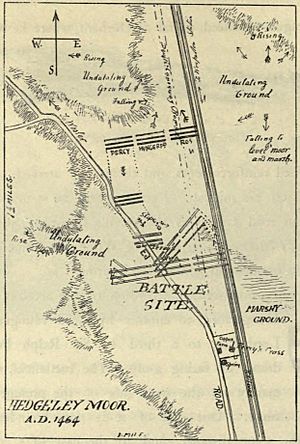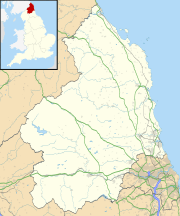Battle of Hedgeley Moor facts for kids
Quick facts for kids Battle of Hedgeley Moor |
|||||||
|---|---|---|---|---|---|---|---|
| Part of the Wars of the Roses | |||||||
 Plan of the battle of Hedgeley Moor (Battles and Battlefields in England, 1896) |
|||||||
|
|||||||
| Belligerents | |||||||
| Commanders and leaders | |||||||
| Strength | |||||||
| 6,000 | 5,000 | ||||||
| Casualties and losses | |||||||
| unknown | unknown | ||||||
The Battle of Hedgeley Moor was a fight that happened on April 25, 1464. It was part of the Wars of the Roses, a long conflict between two powerful English families: the Yorkists (who had a white rose symbol) and the Lancastrians (who had a red rose symbol). This battle took place at Hedgeley Moor in Northumberland, England. The Yorkist army, led by Lord Montagu, won against the Lancastrian army, led by the Duke of Somerset. This victory was important for the Yorkists.
Contents
Why the Battle Happened
At the start of 1464, the Lancastrians hoped to gain more support in England. Meanwhile, the Yorkists wanted to make a peace deal with Scotland. This would stop Scottish armies from invading England.
Peace Talks and Travel
The English parliament was going to meet in York on May 5. They planned to talk with Scottish leaders there. But, the Lancastrians were very active in Northumberland and North Yorkshire. This made it unsafe for the Scottish group to travel to York.
So, Lord Montagu was sent north. His job was to lead a small group of soldiers. Their mission was to safely escort the Scottish leaders to York.
Armies Gather
The Lancastrian leader, the Duke of Somerset, tried to surprise Lord Montagu near Newcastle. But Montagu managed to avoid this trap. He kept moving north, gathering more soldiers as he went.
By the time Montagu reached Hedgeley Moor, he had an army of about 5,000 to 6,000 men. There, he met the Lancastrian army, which had about 5,000 men. The Duke of Somerset led the Lancastrians. Other important Lancastrian commanders included Lords Ros and Hungerford, and Sir Ralph Percy.
The Battle
The fight started with both armies shooting arrows at each other. This was a common way for battles to begin back then.
Yorkist Advance
Lord Montagu then led his Yorkist army forward. They marched across about 1,500 yards of open moorland. But they had to stop and adjust their lines. This happened because the Lancastrian left side, led by Lords Ros and Hungerford, suddenly broke apart. About 2,000 of their soldiers ran away from the battle.
Lancastrian Collapse
When the Yorkists finally clashed with the main Lancastrian line, the entire Lancastrian force gave way. Most of the remaining Lancastrian soldiers fled the field. They were pushed back by the sheer number of Yorkist troops.
Sir Ralph Percy was one of the few who stayed. He fought bravely with his own loyal soldiers. But he was left alone by the rest of his army, including all the other commanders. Sir Ralph Percy was soon killed. As he died, he is said to have spoken some mysterious words: "I have saved the bird in my bosom."
Aftermath
The Yorkist victory at Hedgeley Moor was very important. The Lancastrian army was defeated and scattered. This made it safe for the Scottish leaders to travel to York.
Peace with Scotland
At York, the Yorkists, led by King Edward IV, successfully made a peace agreement with the Scots. This helped secure England's northern border.
Next Battle
The Battle of Hedgeley Moor was soon followed by another important battle. This was the Battle of Hexham, which took place on May 15, 1464. That battle was a decisive defeat for the Lancastrians.
Percy's Cross
Today, a square stone pillar stands near where the battle happened. It is known as 'Percy's Cross'. You can find it on the east side of the A697 road. This is a couple of miles north of the village of Powburn. The road at this point follows the path of an old Roman road called the Devil's Causeway.
Ballads
There are also two poems, or ballads, that remember the battle. They are The Battle of Hedgley Moor by Frederick Sheldon and The Legend of Percy's Cross by James Service.


